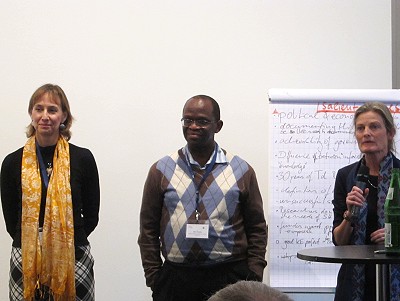Bringing science to communities in South Africa
Dr. Judy Mann of the South African Association of Marine Biological Research (SAAMBR) in Durban gave a passionate talk about the challenges of bringing marine science to different communities in the country. SAAMBR is a non-profit organisation with a staff of about 200. Its objective is to help people to care about the ocean. It pursues its goal against the backdrop of about 32% of the 52 million strong population below age 15, 25% unemployed and 10% HIV positive citizens.
 The three major thrusts of its work are the aquarium, curriculum linked education and wider capacity building particularly in subsistence fishing communities.
The three major thrusts of its work are the aquarium, curriculum linked education and wider capacity building particularly in subsistence fishing communities.
The uShaka Sea World aquarium attracts upwards of 800,000 visitors a year and is the major source of income for all of SAAMBR's research and extension work. The aquarium inspires visitors through the wonders of life underwater and aims to instill a sense of care for the ocean and its creatures. It truly wants to connect people's lives to the ocean and empower personal and group action for its protection.
While some 100,000 pupils visit the aquarium every year, SAAMBR's focus is on supporting teachers so that they can be more effective go-betweens for the young people and their discovery of the ocean. The organisation pays special attention to reaching out to rural communities, who may not have much first hand exposure to the sea.
As many recent fishing communities have neither traditions nor historically grown traditional authorities, they have little or no traditional knowledge about the sea and hardly any understanding why regulations exist. Helping their empowerment so that they can be actors in co-management of the resource also needs better relationships between the government's resource managers and rangers and these communities.
After years of effort, commercial and recreational fishermen show signs of changing attitudes and increase compliance with regulations. But there is no reason to become complacent.
Genuine two-way exchanges and building personal relationships have worked best in creating trust and willingness to listen to one another. Presentations, radio and tv have proven helpful for sharing information.
Providing scientific advice to local environment managers is crucial support as local capacity for law enforcement for the Marine Living Resources Act (1992-94) and the Integrated Coastal Management Act (2000-2008) is minimal. SAAMBR has also extended scientific advice to coastal communities in Mozambique, Tanzania, Kenya and Somalia, but its major focus remains in South Africa.
A recent focus of work is to work with magistrates, prosecutors and judges. These professions are confronted with the high levels of violent crimes on a daily basis and thus do not traditionally consider environmental crimes a priority. Exchanging information with judges, serving as expert witnesses and supplying data to other researchers are all becoming more common to get more people excited about protecting the ocean.
These different fields of work have one question as common denominator: How do people learn? SAAMBR's work clearly indicates that more information per se does not change people's attitudes and actions. What does bring about change is personalised information and support to making sense of the world. It's the passion that helps learning and seeing and participating in activities makes people reflect. When information consists of a problem description, it should be complemented by suggestions of what can be done about it. Without such suggestions, remedial action might not be self-evident or come spontaneously.









